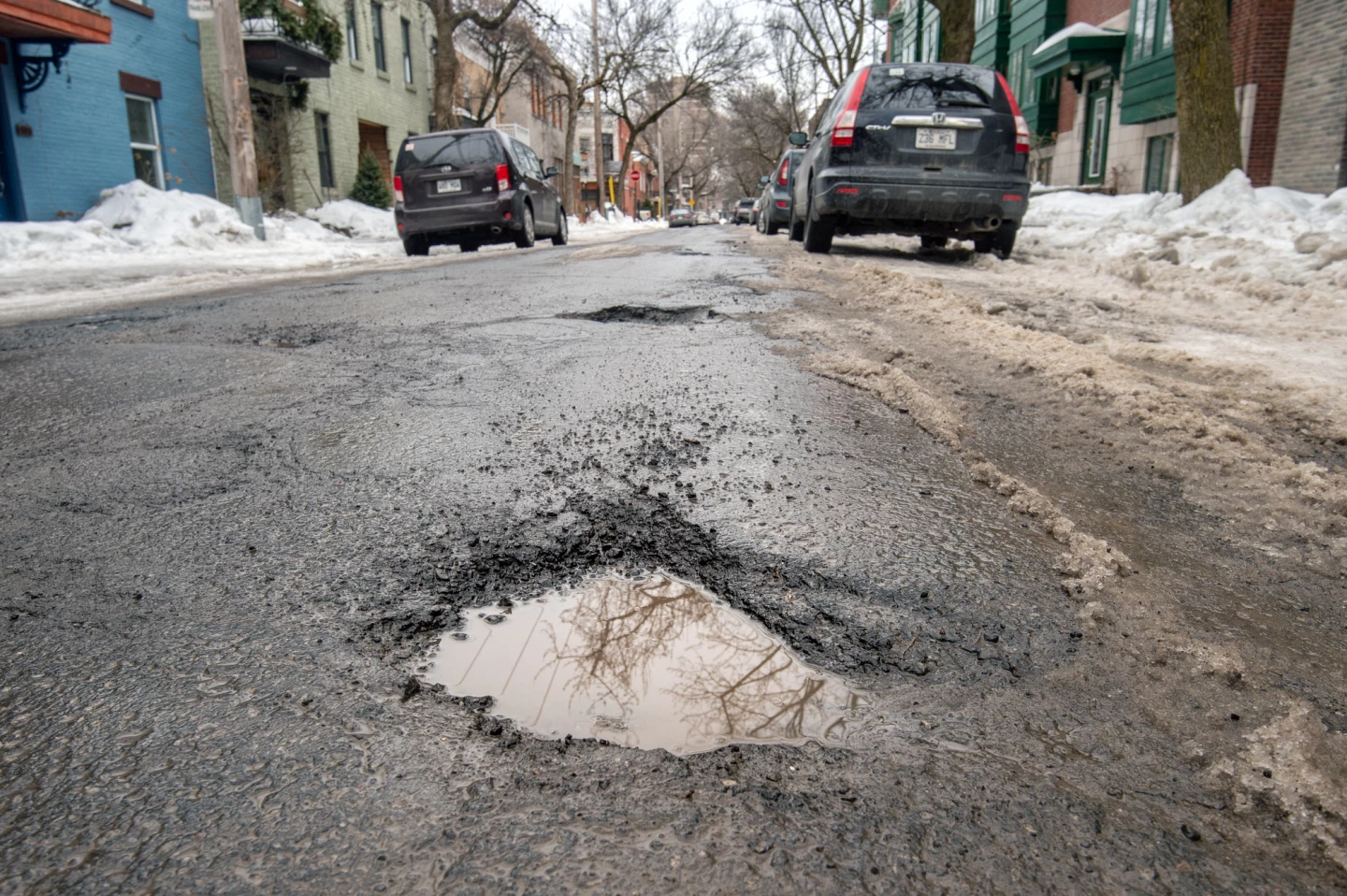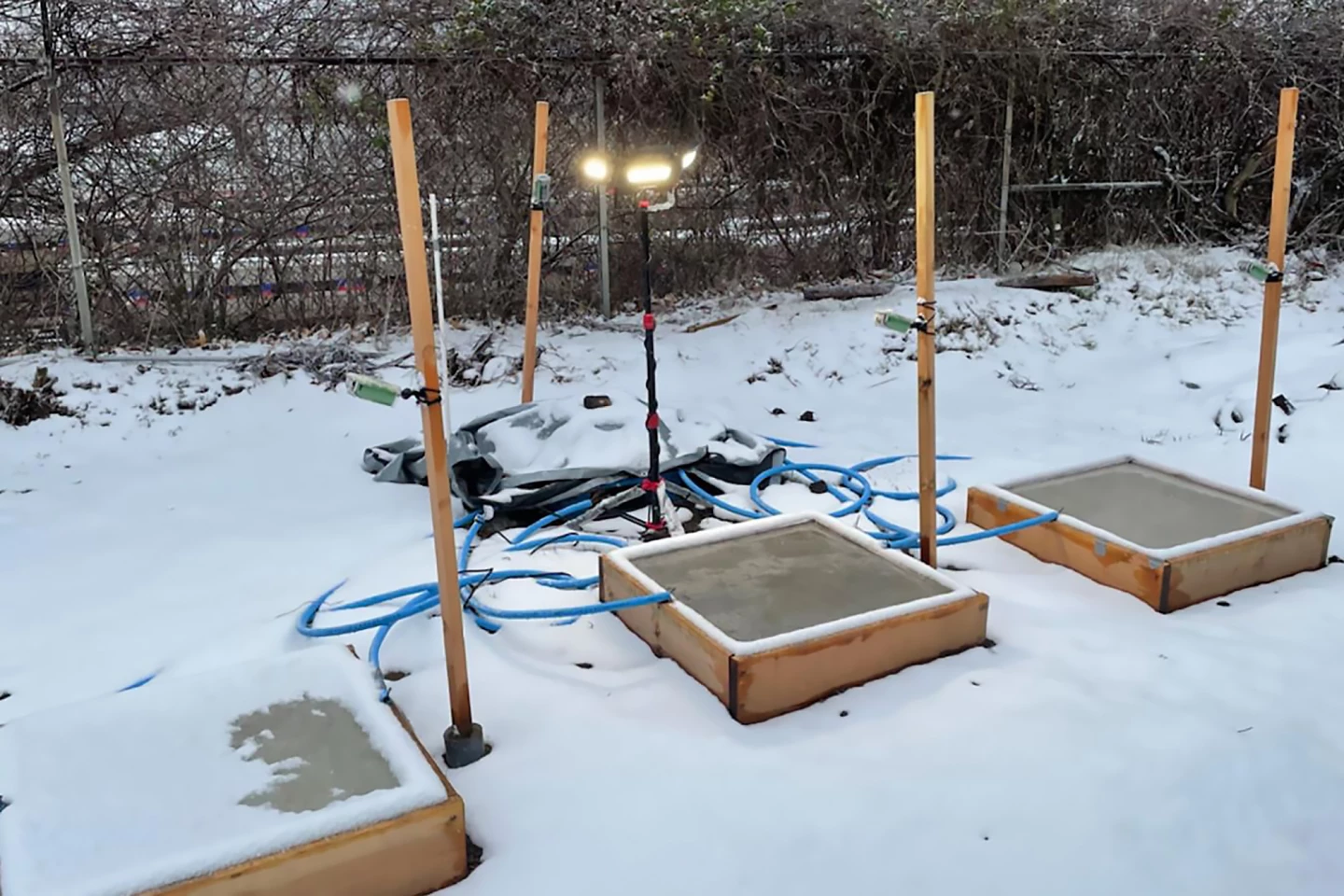Incorporating a phase-change material into concrete, researchers have created a self-heating material that can melt snow and ice for up to 10 hours without using salt or shovels. The novel material could reduce the need for plowing and salting and help preserve the integrity of road surfaces.
According to the US Department of Transportation (DOT), more than 70% of roads are in snowy regions. Snow and ice accumulation reduces road friction and vehicle maneuverability, causing drivers to slow and increasing the risk of crashes. Snow-obstructed lanes and roads also reduce roadway capacity and increase travel time.
The DOT states that local and state agencies spend more than US$2.3 billion annually on snow and ice control operations, in addition to the millions spent repairing infrastructure damage caused by snow and ice. Salting is often used before a snow event to prevent icing, but the highly concentrated salt solution can deteriorate concrete or asphalt. In addition, when water seeps into the road and freezes, it expands, causing internal pressure and damaging the road.
In a new study, researchers from Drexel University in Pennsylvania, US, a known ‘cold state,’ present their self-heating concrete: a potential fix to snowed-over roads and the cost associated with clearing and maintaining them.

“One way to extend the service life of a concrete surfaces [sic], like roadways, is to help them maintain a surface temperature above freezing during the winter,” said Amir Farnam, principal investigator at Drexel’s Advanced Infrastructure Materials (AIM) lab and one of the study’s corresponding authors. “Preventing freezing and thawing and cutting back on the need for plowing and salting are good ways to keep the surface from deteriorating. So, our work is looking at how we can incorporate special materials in the concrete that help it to maintain a higher surface temperature when the ambient temperature around it drops.”
The researchers’ ‘special material’ is paraffin, a so-called phase-change material because it releases heat when it moves from a liquid state at room temperature to a solid state when temperatures drop. In a previous study, they tested phase-change concrete in a thermally controlled lab setting, but in the current study, they tested it in real time, under real-world conditions.
Two methods were used to incorporate paraffin into concrete slabs. In the first, porous lightweight aggregate – the small stones and pebbles added to give concrete its strength – was submerged in and absorbed liquid paraffin before being mixed into the concrete. In the second, micro-capsules of paraffin were mixed directly into the concrete.

The researchers poured three slabs: two with the different methods of paraffin incorporation and a third containing no phase-change material. All three have been outside, next to a parking lot at the Drexel University campus, since December 2021. In the first two years, they were exposed to 32 freeze-thaw events in which the temperature dropped below freezing, regardless of precipitation (that is, rain, drizzle, snow, sleet or hail), and exposed to five snowfalls of one inch or more.
The 30-inch-by-30-inch (76-cm-by-76-cm) slabs’ snow- and ice-melting capabilities were monitored using cameras and thermal sensors. The researchers found that the phase-change concrete maintained a surface temperature of 42 °F to 55 °F (5.6 C° to 12.8 °C) for up to 10 hours when air temperatures fell below freezing. The heat produced was enough to melt a couple of inches of snow at a rate of about a quarter inch per hour.
“We have demonstrated that our self-heating concrete is capable of melting snow on its own, using only the environmental daytime thermal energy – and doing it without the help of salt, shoveling or heating systems,” Farnam said. “This self-heating concrete is suitable for mountainous and northern regions in the US, such as Northeast Pennsylvania and Philadelphia, where there are suitable heating and cooling cycles in winter.”
The lightweight aggregate slab was better at sustaining its heating, maintaining a temperature above freezing for up to 10 hours, whereas the micro-capsule paraffin heated up more quickly but only maintained heat for half the time. The researchers noted that the porosity of the aggregate likely contributes to the paraffin remaining a liquid below its usual freezing temperature of 42 °F, meaning that the slab did not immediately release its heat energy when the temperature began falling but held off until the material reached 39 °F/3.9 °C. This is in contrast to the microencapsulated paraffin slab, which began releasing its heat energy when its temperature reached 42 °F.
“Our findings suggest that the phase-change material treated lightweight aggregate concrete was more suited for deicing applications at sub-zero temperatures due to its gradual heat release within a wider range of temperature,” said Farnam.
The researchers say the ability to prevent a concrete surface from dropping below freezing will help prevent its deterioration.
“Freeze-thaw cycles, periods of extreme cooling – below freezing – and warming, can cause a surface to expand and contract in size, which puts a strain on its structural integrity and can cause damaging cracking and spalling over time,” said Robin Deb, the study’s lead and co-corresponding author. “And while this alone may not degrade the structure to the point of failure, it creates a vulnerability that will lead to the problematic interior deterioration that we need to avoid. One of the promising findings is that the slabs with phase-change materials were able to stabilize their temperature above freezing when faced with dropping ambient temperatures.”

The researchers noted that the slabs were less effective for heavy snow accumulation of more than two inches. And that if the phase-change material didn’t have an opportunity to ‘recharge’ by warming enough to return to its liquid state between freeze-thaw or snow events, performance may be diminished.
They plan to continue collecting data to assess the slabs’ long-term effectiveness and study how incorporating phase-change materials may extend concrete's lifespan.
“With these findings, we will be able to continue to improve the system to one day optimize it for longer heating and greater melting,” Deb said. “But it is encouraging to see evidence of significant reduction of freeze-thaw cycles, which demonstrates that PCM [phase-change material] concrete is more freeze-thaw durable compared to traditional concrete.”
It's unclear from the study whether the paraffin used was synthetic. An issue with using non-synthetic paraffin is that paraffin wax is a byproduct of petroleum (crude oil), a non-renewable resource requiring intensive machinery to mine and refine. As a non-renewable resource, paraffin wax is not sustainable, biodegradable, or environmentally friendly.
The study was published in the Journal of Materials in Civil Engineering.
Source: Drexel University








